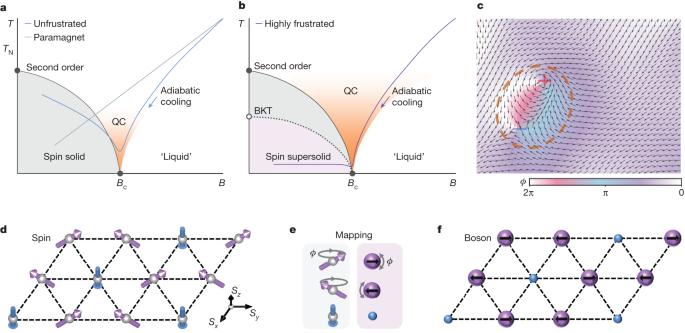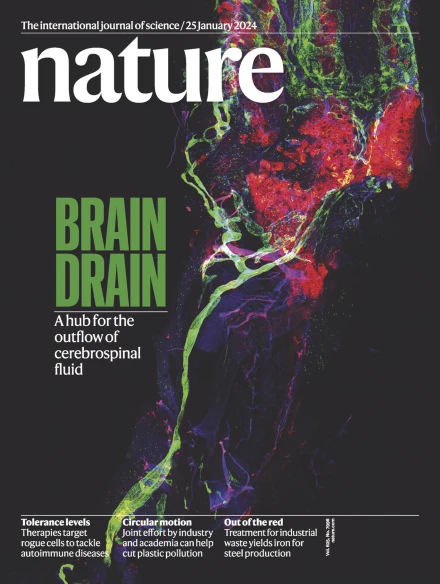Giant magnetocaloric effect in spin supersolid candidate Na2BaCo(PO4)2
IF 50.5
1区 综合性期刊
Q1 MULTIDISCIPLINARY SCIENCES
引用次数: 0
Abstract
Supersolid, an exotic quantum state of matter that consists of particles forming an incompressible solid structure while simultaneously showing superfluidity of zero viscosity1, is one of the long-standing pursuits in fundamental research2,3. Although the initial report of 4He supersolid turned out to be an artefact4, this intriguing quantum matter has inspired enthusiastic investigations into ultracold quantum gases5–8. Nevertheless, the realization of supersolidity in condensed matter remains elusive. Here we find evidence for a quantum magnetic analogue of supersolid—the spin supersolid—in the recently synthesized triangular-lattice antiferromagnet Na2BaCo(PO4)2 (ref. 9). Notably, a giant magnetocaloric effect related to the spin supersolidity is observed in the demagnetization cooling process, manifesting itself as two prominent valley-like regimes, with the lowest temperature attaining below 100 mK. Not only is there an experimentally determined series of critical fields but the demagnetization cooling profile also shows excellent agreement with the theoretical simulations with an easy-axis Heisenberg model. Neutron diffractions also successfully locate the proposed spin supersolid phases by revealing the coexistence of three-sublattice spin solid order and interlayer incommensurability indicative of the spin superfluidity. Thus, our results reveal a strong entropic effect of the spin supersolid phase in a frustrated quantum magnet and open up a viable and promising avenue for applications in sub-kelvin refrigeration, especially in the context of persistent concerns about helium shortages10,11. Evidence for a quantum magnetic analogue of a supersolid appears in a recently synthesized antiferromagnet showing a strong magnetocaloric effect of the spin supersolid phase with potential for applications in sub-kelvin refrigeration.

自旋超固态候选物质 Na2BaCo(PO4)2 中的巨磁效应。
超固态是一种奇异的量子态物质,由粒子组成不可压缩的固态结构,同时显示出零粘度的超流动性1,是基础研究领域长期追求的目标之一2,3。尽管最初关于 4He 超固态的报道被证明是一个伪命题4,但这一引人入胜的量子物质激发了人们对超冷量子气体的热情研究5-8。尽管如此,在凝聚态物质中实现超稳定仍是一个未知数。在这里,我们在最近合成的三角晶格反铁磁体 Na2BaCo(PO4)2(参考文献 9)中发现了超固态的量子磁性类似物--自旋超固态。值得注意的是,在退磁冷却过程中观察到了与自旋超固性相关的巨大磁致效应,表现为两个突出的谷状状态,最低温度低于 100 mK。不仅存在一系列实验确定的临界磁场,而且退磁冷却曲线也与采用易轴海森堡模型的理论模拟显示出极好的一致性。中子衍射也成功地定位了所提出的自旋超固相,揭示了三子晶格自旋固态有序性和表明自旋超流动性的层间互不可比性的共存。因此,我们的研究结果揭示了受挫量子磁体中自旋超固相的强熵效应,并为亚开尔文制冷领域的应用开辟了一条可行且前景广阔的途径,尤其是在氦气短缺问题一直备受关注的背景下10,11。
本文章由计算机程序翻译,如有差异,请以英文原文为准。
求助全文
约1分钟内获得全文
求助全文
来源期刊

Nature
综合性期刊-综合性期刊
CiteScore
90.00
自引率
1.20%
发文量
3652
审稿时长
3 months
期刊介绍:
Nature is a prestigious international journal that publishes peer-reviewed research in various scientific and technological fields. The selection of articles is based on criteria such as originality, importance, interdisciplinary relevance, timeliness, accessibility, elegance, and surprising conclusions. In addition to showcasing significant scientific advances, Nature delivers rapid, authoritative, insightful news, and interpretation of current and upcoming trends impacting science, scientists, and the broader public. The journal serves a dual purpose: firstly, to promptly share noteworthy scientific advances and foster discussions among scientists, and secondly, to ensure the swift dissemination of scientific results globally, emphasizing their significance for knowledge, culture, and daily life.
 求助内容:
求助内容: 应助结果提醒方式:
应助结果提醒方式:


